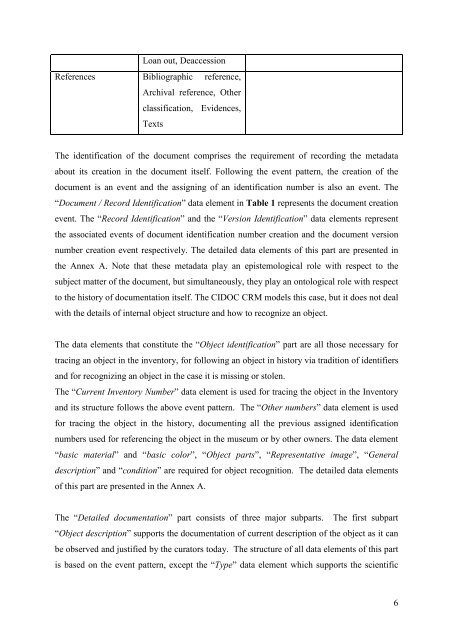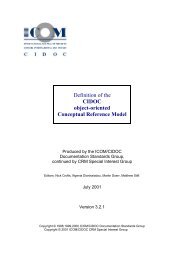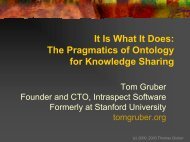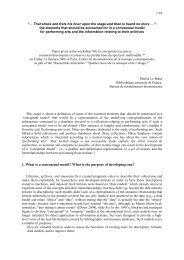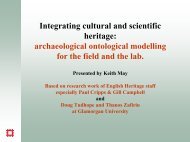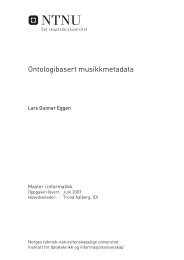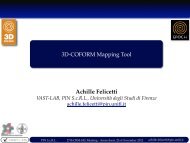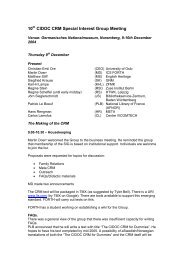documenting cultural heritage in small museums - The CIDOC CRM
documenting cultural heritage in small museums - The CIDOC CRM
documenting cultural heritage in small museums - The CIDOC CRM
Create successful ePaper yourself
Turn your PDF publications into a flip-book with our unique Google optimized e-Paper software.
Loan out, DeaccessionReferences Bibliographic reference,Archival reference, Otherclassification, Evidences,Texts<strong>The</strong> identification of the document comprises the requirement of record<strong>in</strong>g the metadataabout its creation <strong>in</strong> the document itself. Follow<strong>in</strong>g the event pattern, the creation of thedocument is an event and the assign<strong>in</strong>g of an identification number is also an event. <strong>The</strong>“Document / Record Identification” data element <strong>in</strong> Table 1 represents the document creationevent. <strong>The</strong> “Record Identification” and the “Version Identification” data elements representthe associated events of document identification number creation and the document versionnumber creation event respectively. <strong>The</strong> detailed data elements of this part are presented <strong>in</strong>the Annex A. Note that these metadata play an epistemological role with respect to thesubject matter of the document, but simultaneously, they play an ontological role with respectto the history of documentation itself. <strong>The</strong> <strong>CIDOC</strong> <strong>CRM</strong> models this case, but it does not dealwith the details of <strong>in</strong>ternal object structure and how to recognize an object.<strong>The</strong> data elements that constitute the “Object identification” part are all those necessary fortrac<strong>in</strong>g an object <strong>in</strong> the <strong>in</strong>ventory, for follow<strong>in</strong>g an object <strong>in</strong> history via tradition of identifiersand for recogniz<strong>in</strong>g an object <strong>in</strong> the case it is miss<strong>in</strong>g or stolen.<strong>The</strong> “Current Inventory Number” data element is used for trac<strong>in</strong>g the object <strong>in</strong> the Inventoryand its structure follows the above event pattern. <strong>The</strong> “Other numbers” data element is usedfor trac<strong>in</strong>g the object <strong>in</strong> the history, <strong>document<strong>in</strong>g</strong> all the previous assigned identificationnumbers used for referenc<strong>in</strong>g the object <strong>in</strong> the museum or by other owners. <strong>The</strong> data element“basic material” and “basic color”, “Object parts”, “Representative image”, “Generaldescription” and “condition” are required for object recognition. <strong>The</strong> detailed data elementsof this part are presented <strong>in</strong> the Annex A.<strong>The</strong> “Detailed documentation” part consists of three major subparts. <strong>The</strong> first subpart“Object description” supports the documentation of current description of the object as it canbe observed and justified by the curators today. <strong>The</strong> structure of all data elements of this partis based on the event pattern, except the “Type” data element which supports the scientific6


